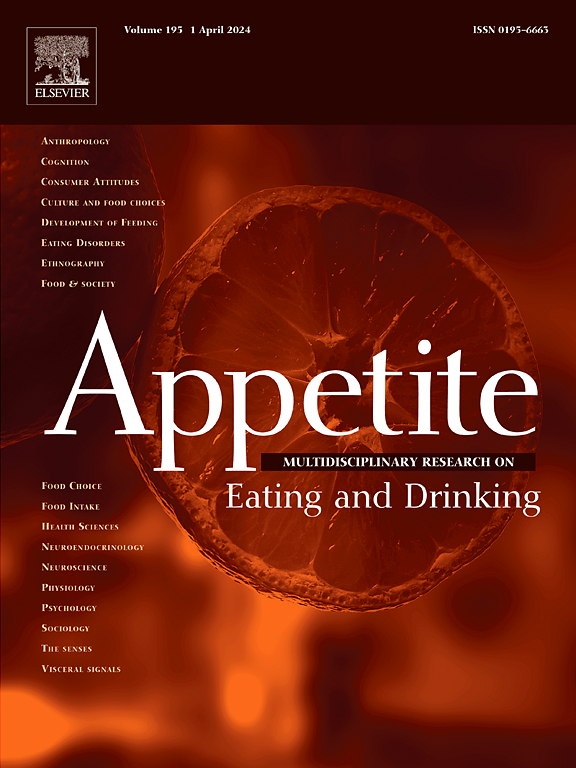对代谢和减肥手术后一段时间内消极情绪与饮食失控之间关系的自然评估。
IF 4.6
2区 医学
Q1 BEHAVIORAL SCIENCES
引用次数: 0
摘要
饮食失调行为与代谢和减肥手术(MBS)后的不理想体重结果有关,从而威胁到治疗严重肥胖症的最有效方法。虽然多达 40% 的患者在接受代谢和减重手术后可能会出现饮食失控(LOC),但这种行为的驱动机制尚未完全明了。初步证据表明,当下高水平的负性情绪(NA)会促使 MBS 术后出现 LOC 进食;然而,这种当下的关系是稳定的,还是会在术后最初几年内发生变化,目前仍不清楚。因此,本研究利用三波生态学瞬间评估数据收集,考察了NA与MBS术后LOC进食严重程度之间的前瞻性关系差异。参与者(n=143,87% 为女性)被要求在 MBS 术后 1、2 和 3 年的 7 天内,每天用智能手机对 NA 和 LOC 饮食严重程度进行≥5 次的瞬间评分。NA和LOC饮食均采用1-5分的李克特量表进行评分,分数越高表示症状越严重。NA以人内和人际为中心,并作为LOC进食严重程度的前瞻性预测指标。分析评估了MBS后的时间是否会调节两者之间的关系。一个广义线性混合模型表明,当以受试者内部和受试者之间为中心时,NA 越高,则下一次信号发出时 LOC 进食越严重。MBS后的时间调节了NA内对LOC进食严重程度的影响,因此这种关系在第1年和第2年之间保持不变,但在第2年和第3年之间得到加强。研究结果表明,随着MBS术后时间的推移,瞬间NA对LOC进食严重程度的预测作用越来越强,这对旨在减少LOC进食和促进术后最佳体重结果的干预措施具有重要意义。本文章由计算机程序翻译,如有差异,请以英文原文为准。
A naturalistic assessment of the relationship between negative affect and loss of control eating over time following metabolic and bariatric surgery
Disordered eating behavior has been linked to suboptimal weight outcomes following metabolic and bariatric surgery (MBS), thereby threatening the most efficacious treatment for severe obesity. While up to 40% of patients may experience loss of control (LOC) eating following MBS, mechanisms driving this behavior are not fully understood. Preliminary evidence suggests that high levels of negative affect (NA) in the moment prompt LOC eating post-MBS; however, it remains unclear whether this momentary relationship is stable or changes over the first several years following surgery. Consequently, this study examined differences in the prospective relationship between NA and LOC eating severity over time post-MBS using three waves of ecological momentary assessment data collection. Participants (n = 143, 87% female), were asked to rate momentary levels of NA and LOC eating severity on their smartphone ≥5 times/day for 7 days at 1-, 2-, and 3-years post-MBS. Both NA and LOC eating were rated on a 1–5 Likert scale, with higher scores indicating more severe symptoms. NA was within- and between-person centered and used as a prospective predictor of LOC eating severity. Analyses evaluated if time post-MBS moderated the relationship. A generalized linear mixed model demonstrated that higher NA predicted more severe LOC eating at the next signal when centered within- and between-subjects. Time post-MBS moderated the within-NA to LOC eating severity effect, such that the relationship remained unchanged between years 1 and 2, but strengthened between years 2 and 3. Findings suggest that momentary NA becomes a more powerful predictor of LOC eating severity as time passes post-MBS, which has important implications for interventions aimed at reducing LOC eating and promoting optimal weight outcomes in the post-surgical period.
求助全文
通过发布文献求助,成功后即可免费获取论文全文。
去求助
来源期刊

Appetite
医学-行为科学
CiteScore
9.10
自引率
11.10%
发文量
566
审稿时长
13.4 weeks
期刊介绍:
Appetite is an international research journal specializing in cultural, social, psychological, sensory and physiological influences on the selection and intake of foods and drinks. It covers normal and disordered eating and drinking and welcomes studies of both human and non-human animal behaviour toward food. Appetite publishes research reports, reviews and commentaries. Thematic special issues appear regularly. From time to time the journal carries abstracts from professional meetings. Submissions to Appetite are expected to be based primarily on observations directly related to the selection and intake of foods and drinks; papers that are primarily focused on topics such as nutrition or obesity will not be considered unless they specifically make a novel scientific contribution to the understanding of appetite in line with the journal's aims and scope.
 求助内容:
求助内容: 应助结果提醒方式:
应助结果提醒方式:


